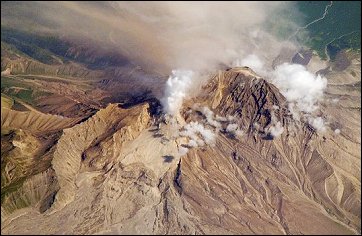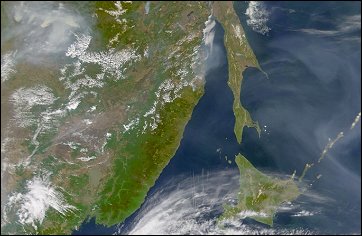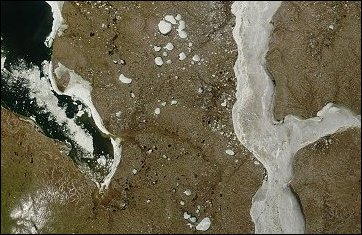Russia
 |
Shiveluch is one of the biggest and most active of a line of volcanoes that
follow the spine of the Kamchatka Peninsula in easternmost Russia. The volcanoes and peninsula are part of the
tectonically active "Ring of Fire", a zone of active volcanoes and frequent earthquakes that nearly surrounds the Pacific Ocean..... ....read more |
 |
When the Pleistocene Ice Age reached its peak around 22,000 years ago, continent-spanning glaciers covered large sections of North America and Eurasia like a sheet. As the Ice Age waned, the glaciers retreated. Occasionally large chunks of ice broke off from the glacier and became surrounded or even buried by soil and rock debris deposited by the melting ice sheet..... ....read more |
 |
Russia's Volga River is the largest river system in Europe, draining over 1.3
million square kilometers of catchment area into the Caspian Sea. The brackish
Caspian is Earth's largest landlocked water body, and its isolation from the world's
oceans has enabled the preservation of several unique animal and plant species. ....read more |
 |
Extensive forest fires in Eastern Russia have been sending large volumes of smoke into the atmosphere over the Sea of Okhotsk and Kamchatka Peninsula. The smoke (greyish pixels) is easy to see in this SeaWiFS image against the relatively dark background of the northwestern Pacific Ocean. ....read more |
 |
Located about 55 kilometers (34 miles) to the northwest of Lake Baikal, Irkutsk
(Russia) is also the chief city of Irkutsk Oblast (province) in Siberia. The city is located on the Angara River and was originally a tax collection outpost for local fur trappers. ....read more |
 |
Russia’s Ob River flows from south to north, and each summer, it thaws in the same direction. The result is that an ice jam sits downstream from thawed portions of the river, which is laden with heavy runoff from melted snow. ....read more |



 Home
Home